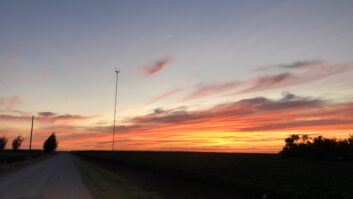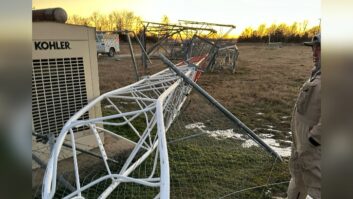Before reading this article, read and consider the question shown in the box.
SBE certification is the emblem of professionalism in broadcast engineering. To help you get in the certification exam frame of mind, Radio World Engineering Extra poses a typical question in each edition. Although similar in style and content to exam questions, these examples are not from past exams nor will they be on future exams in this exact form.

The correct answer to the question in the box is d.
In a strange twist of regulations, the Federal Aviation Administration can only recommend tower lighting and marking (L&M). However, the Federal Communications Commission can require it from radio stations. Installation and maintenance of the dictated L&M usually is a condition of the station license grant.
The first stage of the tower permitting process on the federal level is FAA review, which you hope concludes in a “Determination of No Hazard.”
You should think of this as a determination that “no hazard if the following is accomplished,” and that “if” usually is the L&M.
(In a case in which I was involved, the “marking” requirement included installation of a non-directional VLF radio beacon to allow aircraft to navigate around the tower. Be happy if all you need do is light and paint your tower.)
All that follows stems from the FAA review, so keep a complete copy of that document.
The Antenna Structure Registration (ASR) program now allows the FCC to keep track of the existence and construction status of support structures that fall into the serious, coordinated category.
All structures that require lighting and marking must be registered. In general, this covers structures with height more than 199 feet above ground level, which includes short towers on top of tall buildings that top out over 199 feet AGL, and even some shorter structures near airports.
The majority of applications for transmission sites are processed using the site’s ASR number; and if the site requires ASR status, no grant will be issued until registration is accomplished. Site owners must issue a copy of the ASR to tenants for their records as soon as their presence at the site is formalized, such as when they file an FCC application for the site or sign their lease. (We may get a rule change after which owners would be required only to supply the Web location of the ASR record.)
If your station is a tenant and you do not have a copy of the ASR, request a copy of the original. If the owners do not furnish a copy, print the record off of the Wireless Branch ASR Web site just to CYA.
The last license issued for a site dictates the Lighting and Marking, so check whenever a new “instrument” is issued. If the L&M requirement does not match your existing installation — such as specifying day and night strobes instead of medium strobes by day and reds at night — these changes must be made or a petition initiated for them to be corrected to the existing L&M circumstances.
Ignore this at your own jeopardy. No matter what, changes in L&M must be reflected in all licenses to the current, annotated requirements. Having a copy of the last license issued with L&M requirements on it clarifies the issue and demonstrates that you are in compliance.
Since most of these L&M directives are issued automatically based on computer reviewed criterion, most often the computer attaches the normal and current regulation based directives for L&M to match the elevation and location of your support structure. These directives quite often are not the L&M arrangements that you might actually have as a function of operating an older, grandfathered installation or allowed under special circumstances. A few towers require no L&M as they are surrounded by higher hills or in the midst of tall, brilliantly lighted buildings.
There is a legendary story of the Empire State Building being given a marking requirement of alternating bands of international orange and white courtesy of an erroneous key stroke. Check the Lighting and Marking requirements. If they are wrong, persevere until you get them corrected; otherwise you may be installing strobes in January to take the place of those red lights you’ve been running for 50 years in addition to receiving a healthy Notice of Apparent Liability (read: an FCC fine).
Towers are required to be inspected physically every quarter and at intervals no more then five months apart unless you enjoy one of those infamous individual special ruling exceptions; see section 17.47(b) of the FCC Rules.
(click thumbnail)
Sample Inspection Form On the federal level, maintenance and confirmation of the operation of the Lighting and Marking are paramount, but for Building Officials Code Authority, OSHA, insurance and CYA, the structure needs to be structurally inspected as well. You don’t need to bring in the outside engineers, but you do need to check for loose guys, deteriorated or missing ground wires, rust, obvious vertical distortion and such, logging your observations and corrections.
If you have automatic lighting failure warning systems, operation must be checked and confirmed as part of the 90-day inspections. Although there is no specific requirement for preservation of these inspections, I suggest you keep the last two years of original inspections on file, based on guidelines we find at the federal level.
The graphic shown here is a typical tower inspection form; if you’d like a more detailed one, check out one that the state of Maryland uses (this is a PDF download) at tinyurl.com/inspectionRW.
A note about coordinates on documents: FCC licenses under Part 73 most likely will be in the North American Datum of 1927. ASR and Part 74 licenses will be in NAD-83. Remarkably, I often find that somehow the coordinates have become confused.
If you have not checked that the real and accurate coordinates have been used uniformly in all your paperwork, do so. And check new paperwork when it arrives so the integrity of your numbers is maintained. This includes the licenses that your tenants maintain as well.
As a side note and by way of a reminder, all towers that have an ASR number are required to have it posted visibly on or near the tower. Additionally the FCC has “clarified” this rule that the number should also be posted at the nearest point that the general public can approach the tower. So if you can see the tower at the end of the driveway and that’s as close as the public can come, the ASR number has to be posted there as well. In extreme cases — say, your tower is out on a private island — the ASR number has to be posted at the nearest public point as well as the private island buoy sign or at the nearest public pier.
If all of the above is not enough, most sites require an “RF Plan” a directive from another corner of the federal government that addresses mainly non-ionizing RF radiation. Since this document is more closely coupled with OSHA, we’ll address this separately in a future column.
Don’t forget, the deadline to sign up for the next SBE certificate exams at the local chapter level is Dec. 31. Details at www.sbe.org. Good luck!
* * *
A CBRE-level question for the February issue:
You have installed a new solid-state transmitter in place of your old tube rig using the same power connections. On cold start the supply panel circuit breaker trips but if you reset the CB fast enough and restart, the rig will run without a trip. What is the most likely cause?
a. When running, solid-state transmitters intrinsically consume more current then comparable tube rigs.
b. You have reversed the phase and neutral wires.
c. The current inrush caused by the highly reactive input of switching supplies used in most solid-state transmitters exceeds the current “trip curve” of the circuit breaker.
d. You have forgotten to install utility power line surge protection.
e. You cannot start up a solid-state transmitter with modulation applied.
Buc Fitch, P.E., CPBE, AMD is a frequent contributor to Radio World.












